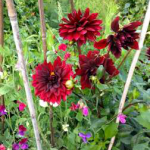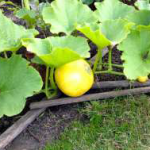

Maintaining soil and structures and planning ahead
- Deep-dig out perennial weeds such as invasive bindweed and couch grass. Keep weeding to prevent weeds seeding.
- Begin to add well rotted manure to bare areas.
- Empty the compost bin by bagging up compost from the bottom of the bin or heap. Store it ready for use next spring and start a new mix.
- Cut bean and pea plants away at ground level when they have finished cropping. Leave the roots to slowly release nitrogen back into the soil.
- Empty the compost bin by bagging up compost from the bottom of the bin or heap and store ready for use next spring.
- In the greenhouse, rake off the top centimetre of soil to clear out any pests near the surface and replace with grit. Next spring remove the grit and replace with clean potting compost.
Sowing and growing
- Spinach, coriander, rocket and parsley can all be sown until the middle of the month.
- Sow fast-growing Oriental greens such as pak choi and mizuna.
- Sow winter greens such as land cress, corn salad and hardy lettuce cultivars (including ‘Arctic King’ and ‘Valdor’) for spring picking. Sow kale for early spring harvesting and rocket for autumn harvesting.
- Sow hardy annuals such as calendula officianalis in shallow drills for late spring flowering next year.
- Sow green manures in vegetable beds that are to be left fallow for the winter. When dug in they conserve nutrients and improve soil texture.
- Sow broad bean varieties such as Aquadulce, de Monica or Masterpiece Green Longpod in late September for harvesting in late May, early June.
- Pot up strawberry runners to make new plants for next summer or plant out new strawberries.
- Plant out spring cabbage.
- Plant overwintering onion sets.
- Plant daffodil bulbs for early spring flowering.
- Start planting trees at the end of the month while the soil is still warm.
- Harvest maincrop potatoes. Check each tuber for disease or damage and do not store damaged tubers. Store in a cool, dry place. Let the tubers dry off before storing in jute, hessian or paper bags in a dark frost-free place.
- Protect leafy vegetable crops with bird netting.
- Cut out the fruited canes of summer raspberries, blackberries, loganberries and tayberries. Leave the new green canes as these will crop next year. Prune blackcurrants. After picking autumn-fruiting raspberries, do not prune. Wait until late winter/ early spring to cut all the canes down to ground level.
- Continue to feed and water tomatoes. Pinch out the tips of cordon tomatoes to concentrate the plants energy into fruiting. Cropping can continue well into the autumn.
- In the greenhouse sow herbs, salad leaves such as pea shoots, beetroot and chard for winter leaves.
- Apply grease bands to fruit trees at the end of the month to deter winter moth.
- Keep leeks protected with insect mesh against leek mining fly and leek moth.
- Do not compost blight-affected foliage or tubers of potatoes and tomato plants or rose leaves affected with black spot.
Harvesting
- Store onions that have been dried in nets in well-ventilated conditions.
- Continue to harvest sweetcorn.
- Cut herbs for drying and use throughout the winter.
- Continue picking autumn raspberries and blackberries.
- Ensure carrots are protected with insect mesh as carrot flies are most damaging in late summer and autumn.
- Water plants in the morning to help prevent fungal diseases.
- Continue harvesting apples and pears. Store in a cool, well-ventilated place. Black, scabby blotches, distortion and cracking on apples and pears indicates scab disease. Affected fruit will not store well but can be eaten now.
- Leave autumn squashes to ripen on the plant as long as possible and remove the leaves to maximise sunlight. Place fruit on a wooden board or tile to prevent soiling. Fruits are ready when richly coloured and ring hollow when tapped.
Gardening for wildlife
- While tidying up the plot, be sure to leave some seeded flower heads to provide winter food for birds. Leave some areas of dead vegetation for insect life over winter.
- Birds now start to look for food for the winter months so keep bird feeders topped up.
- In ponds, thin out oxygenating and floating plants. Leave debris at the side of the pond overnight so creatures can return to the water. If the pond is near deciduous trees, scoop out the leaves before they sink to the bottom.
Check what produce you may have to enter in the Autumn Show or donate to the produce stall.
